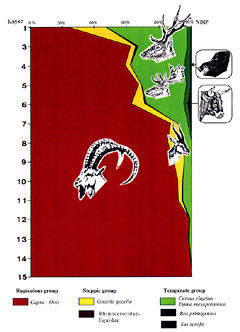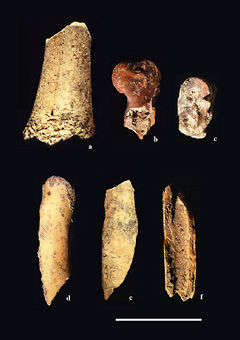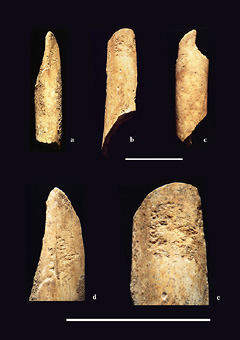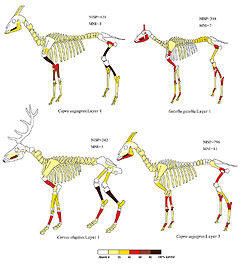
Click on the image to enlarge it. |
The faunal sequence of the Dederiyeh Cave.
In the lower layers including Layer 11, wild goat (Capra aegagrus) and wild sheep (Ovis ammon) were the primary hunted species, amounting to more than 80% of the entire faunal assemblage. On the other hand, in Layer 3, ALThough wild goat and sheep were still the dominant species, the percentage was reduced by half and red deer (Cervus elaphus), fallow deer (Dama mesopotamica), boar (Sus scrofa), and wild oxen (Bos primigenius) were very common.
At the time of Layer 3 as warmer than those prevailing during the deposition of Layer 11. red deer, fallow deer, boar, and wild oxen are known as mammals from temperate zones, preferring relatively humid and a moderate climate. Thus the increase of humidity in the area where the cave is situated led to the establishment of forests covering not only the slopes of the Rift Valley but also the bottom of the valley. It seems that this conclusion is supported by the presence of numerous petrified seed remains of Celtis (hackberry) and many fireplaces that were exposed in Layer 3 (from Griggo, 2003: Fig. III-1). |

Click on the image to enlarge it. |
Examples of gnawing damage by carnivora, cut marks, and human-caused fracture.
(Scale bar = 5 cm) (From Griggo, 2003: Plate III-1.)
- Proximal metatarsal of Bos primigenius (wild ox), showing tooth punctures produced by carnivora (Layer 1).
- Distal part of the humerus of Capra aegagrus (wild goat), showing cut marks on medial face produced during dismemberment (Layer 3).
- Talus of Capra aegagrus, showing cut marks on lateral face produced during dismemberment (Layer 3).
- Middle part of the humerus Capra aegagrus, showing cut marks produced during filleting (Layer 3).
- Middle part of the femur of Capra aegagrus, showing cut marks produced during filleting (Layer 3).
- Middle part of the tibia of Capra aegagrus, showing percussion impact notch on shaft broken for marrow (Layer 3).
|

Click on the image to enlarge it. |
Example of cut marks.
(From Griggo, 2003: Plate III-1e.) |

Click on the image to enlarge it. |
The Middle Paleolithic retouchers of the Dederiyeh Cave.
(Scale bar = 5 cm) (From Griggo, 2003: Plate III-2.)
- Middle part of the tibia of Capra aegagrus (wild goat) (Layer 1).
- Middle part of the left femur of Cervus elaphus (red deer) (Layer 1).
- Middle part of the femur of Dama mesopotamica (fallow deer) (Layer 1).
- Middle part of the tibia of Capra aegagrus (wild goat) (Layer 1).
- Middle part of the left femur of Cervus elaphus (red deer) (Layer 1).
|

Click on the image to enlarge it. |
Anatomical representation of faunal remains.
In order to check whether or not the absence of certain skeletal parts is due to carnivore activity preceding the transport of the ungulate carcass to Dederiyeh Cave by humans, we have calculated the frequencies of the different anatomical parts for those taxa whose number of remains was sufficient. The data shows that there is significant difference between the frequencies of the limb bones corresponding to the anatomical parts having high nutritional values, and the cranial bones, the vertebra, and the ribs corresponding to parts having low nutritional values (from Griggo, 2003: Fig. III-3). | |
